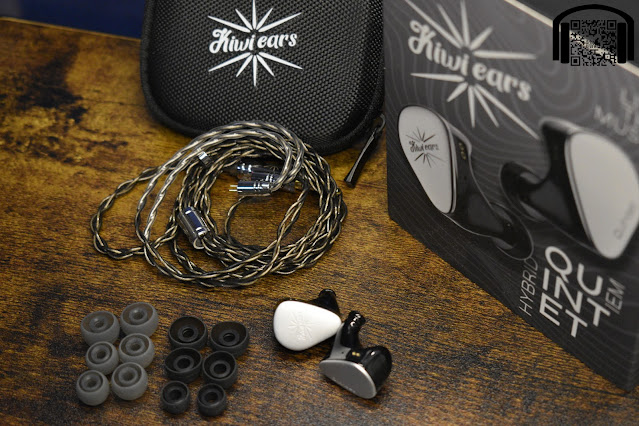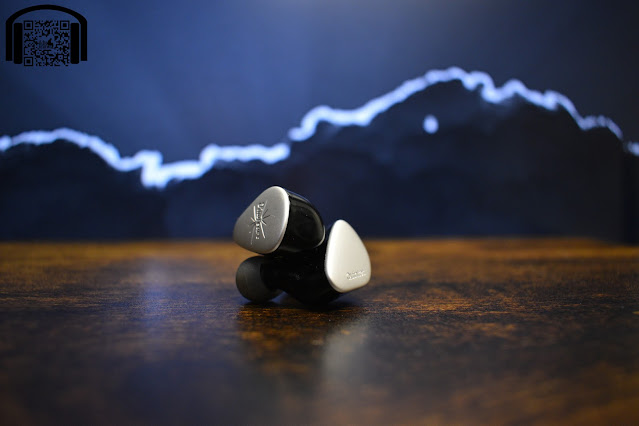- Get link
- X
- Other Apps
English | Español
TLDR version on YouTube: TDLR - Kiwi Ears Quintet
The Kiwi Ears Quintet have been sent to me by Linsoul in exchange for the publication of this review. Linsoul have not made any requests or comments and I will do my best to be as unbiased as humanly possible, although it is always good to take into consideration that these IEMs have not cost me anything.
You can find the Quintet via Linsoul here: https://www.linsoul.com/products/kiwi-ears-quintet
As always, this is a non affiliate link, meaning I do not receive anything in exchange for clicks or purchases made through said link.
To avoid being repetetive in my reviews, you can find all the info about how I create the reviews, equipment used, how I receive the products and how to interpret my reviews by visiting: About my reviews
Intro…
I recently reviewed the Quartet, a quad driver IEM by Kiwi Ears, and mentioned that there have been quite a few releases from them lately. The Quintet is the latest of those releases, featuring 5 drivers (as the name would imply) and coming in at just over 200€, from Linsoul, at the time of putting this review together. That places it just a little cheaper than the Orchestra Lite and leaves 2 cheaper models (plus a more expensive Orchestra, which is the TOTL from Kiwi).
The drivers featured in the Quintet are a DLC dynamic driver, 2 balanced armature drivers, a planar magnetic driver, and a piezoelectric bone conductor. This makes for quite a complex setup that is very easy to get wrong. The planar magnetic driver is something they call an MPT (Micro Planar Transducer) and there is some debate as to whether this should actually be referred to as a planar or not. However, I am not here to debate the technology, I am here to tell you what I think about the performance of the IEMs, and let me say that I am impressed.
Presentation…
There is really not much to say about the presentation that I haven’t already said in my last 3 reviews of Kiwi Ears IEMs. The packaging is the same as the Cadenza, which is the same as the Orchestra Lite, which is the same as the Quartet… just the image on the cover and the name of the model changes.
Inside the box there isn’t much that differs from the other 3 models either. Compared to the Cadenza, we get a transport/storage case (which is the same as the one included with the Orchestra Lite and the Quartet). In comparison to the Quartet, we don’t get the little tool to move the DIP switches, which is to be expected, as the Quintet doesn’t have any switches to move.
I will say that I prefer the cable that is included with the Quintet. It is similar to the cables included with the other models but in a greyish brown colour which I am a fan of.
In general the presentation is good, the contents are decent and I have no complaints about them.
Build and aesthetics…
The build and aesthetics are something that sets the Quintet apart from the other models in the brands line up. Where the others all featured a resin shell with a marble effect finish, the Quintet goes for a more discreet metal faceplate mounted on to a plain black resin shell.
To be honest, I really like the marble effect finish but the simple design of the Quintet is not something that I find ugly either. It is certainly more discreet (although the marble effect I didn’t personally find to be too “loud” anyway) and shouldn’t be a turn off for anyone, unless they have a dislike for simplicity.
The build is just as good as on the full resin options, with the faceplates seemingly well attached and no sign of any flaws, but only time will tell in this regard.
While I don’t think the Quintet are anything special to look at, I certainly have no complaints about their build or aesthetics either.
Sound…
All tracks mentioned are clickable links that allow you to open the reference track in the streaming service of your choice (YouTube, Tidal, Qobuz, Spotify, etc.)
Here is where things get interesting and where I found myself enjoying the Quintet very much. Before getting into my usual description of how the IEMs perform sound wise, let’s take a look at the frequency response in comparison to my usual preference curve for reference:
While on the subject of graphs, let me mention something that I find interesting. If you have been following my reviews, especially in the budget section, I have said multiple times that the Kiwi Ears Cadenza are one of my top picks in the under 50€ segment. In fact, they are probably only second to the Zero: Red in this regard.
Well, here is the graph of the Quintet in comparison to the budget Cadenza:
As you can see, the tuning is very similar and to the ear, the Quintet do actually come across to me as a refined and improved Cadenza, with better technical performance and some very slight changes in the FR which I have to say I like.
(By the way, if you want to compare the Quintet to the other Kiwi Ears models, or any of the IEMs I have measured, you can do so here: achoreviews.squig.link)
But let’s go through the usual procedure and start in the lowest of ranges, using my obligatory “Chameleon” bass work out test track. There is plenty of subbass to create those low rumbling notes that are present in this track. Yet, while the presence is there, I did find that there is a clarity that takes away from the background vibrations that are so often present when listening to “Chameleon” on a subbass heavy set. To put it into context, it is like having a couple of small and fast subwoofers, rather than a large and rumbling subwoofer. I say this because, while there is certainly a boosted presence in subbass, I wouldn’t say that, upon listening, that these are focused towards a basshead market.
“Royals” is a better way to showcase what I mean, where the subbass is certainly present and clean, showing that dirt that I associate with this track in these regions, yet staying out of the way as far as the low end rumble. I can’t say that it is the best subbass I have heard but it is certainly on the good side of things.
As we move into the midbass, there is a slight boost but it is very well done and works well for things like “Sun Is Shining”, where the bass is very nicely presented in a clean and precise way. My fatigue test with “Crazy” proves to give the guitar a nice body to it without being overly boomy, making the track enjoyable. Yes, there is a noticeable presence but it is not something that I dislike.
John Paul Jones’ bass guitar in “Whole Lotta Love” has a very nice thump to it, making its presence felt and not just heard. I did find that Prince’s bass in “Black Muse” was a little more boomy than I expected but that is a minor thing, it still sounds very good.
The mid range is very nicely balanced, with good presence throughout, climbing smoothly to a presence peak just under 3kHz in the upper mids, bringing vocals forwards into the light. There are tracks which have an overly present midbass range in their recordings that can overshadow the mids slightly, yet with good recordings, I find the balance to be pleasant and natural.
For vocal and acoustic based music, which accounts for a lot of my listening time, I find instruments to have a very nice timbre to them, with a little bit of extra warmth in the lower ranges which I would live without but don’t dislike by any means. For example, the lower percussion in “Hotel California (Acoustic)” does have a bit of boom to it but does not overshadow the guitars or vocals.
Vocals I find to be rather natural, although I do find that on occasions that some female vocals, such as Alison Kraus in “Down to the River to Pray”, can seem to be lacking just a little excitement. As with the slight boomyness in Prince’s bass, this is a very minor thing and is much more of an observation than a complaint from my side.
Moving into the upper ranges, I find them to be very coherent and fairly neutral as far as peaks and sibilance is concerned. Patricia Barber, in my usual “Code Cool” scoring, would be placed around a +1 in my opinion. That is, just above what I would consider neutral but only slightly. In the case of Paul Simon in “Diamonds on the Soles of her Shoes”, I would again place his voice around neutral as far as sibilance is concerned.
Detail in good, with instruments being nicely separated and lingering effects such as the echoes in “All Your Love Turns to Passion” being easily identified. I wouldn’t say the details are amazing but are certainly above average, especially in this price point.
Soundstage is decent, at least above average for a set of IEMs, although they don’t provide a huge soundstage (not many IEMs do). When listening to the binaural recording of “La Luna”, I find that the instruments are slightly closer than I would prefer, with the right front guitar seemingly more centered than on other “wider” presentations, without as much depth towards the front as on other sets.
Conclusion…
I really like the Kiwi Ears Quintet. I would say that they are my favourite IEMs from the brand to date (note that I haven’t heard the original Orchestra, so I cannot compare there). I still feel like the Cadenza are the biggest bang for buck from Kiwi Ears (and a lot of other brands) but in the price range that the Quintet sits in, they are certainly a great set of IEMs. I think I would even go as far as to place them in the top 10 of IEMs I have most enjoyed out of those that I have reviewed, although I would need to decide that after a longer term relationship.
There are a few things that are not perfect but they are minor things, in my opinion, and would have absolutely no doubts about recommending people check them out if they are looking for a reasonably priced, good all round IEM. Especially if you are someone who listens to more modern, well recorded, music.
All FR measurements of IEMs can be viewed and compared on achoreviews.squig.link
All isolation measurements of IEMs can be found on achoreviews.squig.link/isolation
To comment or contact, visit any of the following social media platforms:






.png)

